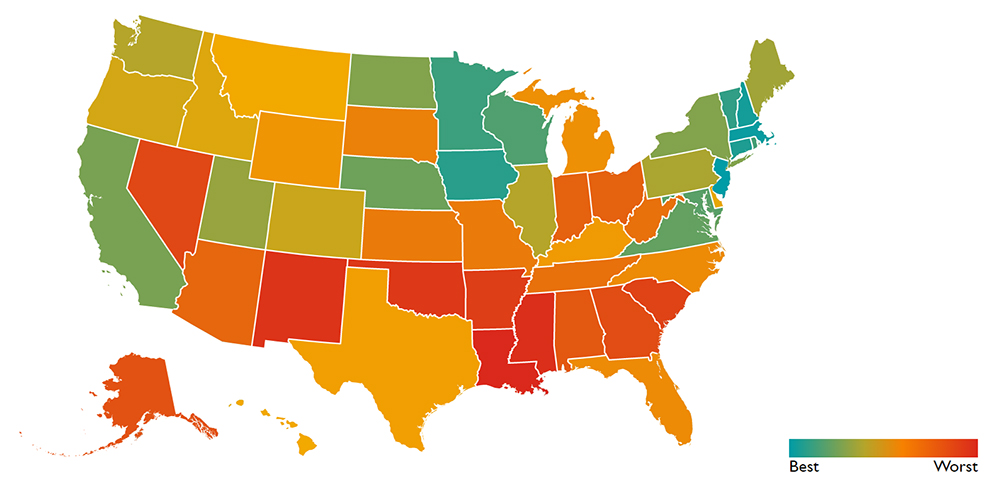FAIRFIELD, Conn. — A report from Save the Children, a humanitarian organization for kids, shows the most disadvantaged counties for children are mostly communities of color, rural, poor and in the South.
The first of its kind report, titled The Land of Inopportunity: Closing the Childhood Equity Gap for America’s Kids, includes a ranking of how counties in the United States protect and provide for its children. The rankings were made based on four factors that end childhood: malnutrition, dropping out of school, teenage pregnancy and early death due to poor health, accident, murder or suicide.
Among the more than 2,600 counties ranked, more than 90% of the bottom-ranked counties are rural; nearly two-thirds are in the South; and three-quarters have non-white majority populations.
The report found the five counties that best protect and provide for their children are Hunterdon (N.J.), York (Va.), Oldham (Ky.), Ozaukee (Wis.) and Carroll (Md.). The five counties where childhoods are most often cut short are Kusilvak (Alaska), Todd (S.D.), Madison (La.), Corson (S.D.) and Bethel (Alaska).
Children who live in bottom-ranked counties die at rates up to five times those of children in the highest-ranking counties in their same state. Additionally, they are up to three times as likely to struggle with hunger, 14 times as likely to drop out of high school, and females are 26 times more likely to have a teen pregnancy.
The report also ranked all 50 states based on five factors: hunger, dropping out, teen pregnancy, infant death and child deaths by homicide and suicide. The analysis determined New Jersey, Massachusetts, New Hampshire, Connecticut and Iowa are the best states for childhood while Louisiana, Mississippi, New Mexico, Oklahoma and Arkansas are the most challenging for children.
“Children fare better in states that spend more on their needs and have champions at every level from the federal government to state houses to community leaders who prioritize child-focused legislation, funding and programs,” said Mark Shriver, senior vice president of Save the Children’s U.S. Programs and Advocacy. “Connecticut, Massachusetts, New Hampshire and New Jersey are among the top 10 states that spend the most per child – including spending on K-12 education, health, income security and social services – and they all place in the top five in this year’s ranking. It doesn’t come as a surprise that more investment is linked to better outcomes for kids.”
Other major findings include:
- States where disparities between top- and bottom-ranking counties are less pronounced are Delaware, Hawaii, Nevada, Arizona and New Hampshire.
- States where disparities between top- and bottom-ranking counties are greatest are Wisconsin, Minnesota, New Jersey and South Dakota.
- Since the last ranking in 2018, Montana made the most progress, jumping up 10 spots; contrarily, Kansas dropped down 9 spots — more than any other states.
- Mississippi has the highest rate of children dying before their first birthday at 8.5 deaths per 1,000 live births; the national average is 5.6.
- More than 9 million children live in the bottom quarter of ranked counties.
- 1 in every 8 children in America is experiencing high rates of food insecurity, school drop out, teenage pregnancy and/or child deaths.
- 17% of all children live in households that lack access to adequate food (food insecurity) sometime during the year.
- New Mexico and Arkansas were the states with the highest child food insecurity rates at 24.1% and 23.6%, respectively — more than twice the rates in Massachusetts and North Dakota.
- Although nearly 90% of counties nationwide are majority white, approximately a third of the 50 bottom-ranked counties are majority African American and over a quarter are majority Native American.
Additionally, the report evaluated 180 countries on how they protect and prioritize children. Singapore, Slovenia, Finland, Sweden and Norway fell in the top five while Niger, Central African Republic, Chad, Mali and South Sudan fell in the bottom five. The U.S. ranked 43rd, trailing nearly all high-income countries in providing support for children.
The report found the overall situation for the world’s children is improving in 121 out of 180 countries but that progress is not happening fast enough for the most vulnerable children.
“A child does not decide where to live, and where a child grows up should not dictate his or her future. We need targeted, new investments for the most vulnerable children who are being left behind, because childhood should not be left to chance,” said Betsy Zorio, vice president of Save the Children’s U.S. Programs & Advocacy. “Raising a more successful generation of children will benefit our nation, and the world, for years to come. Today’s children are tomorrow’s engineers, nurses, teachers, firefighters, entrepreneurs, inventors, humanitarians and simply put, leaders.”
To access the full report, including an interactive map with U.S. state and county data, visit SavetheChildren.org/Childhood.
Click here for information on how you can help Save the Children.













